Scientific name Cicadidae | Superfamily Cicadoidea Higher classification Cicadoidea Rank Family | |
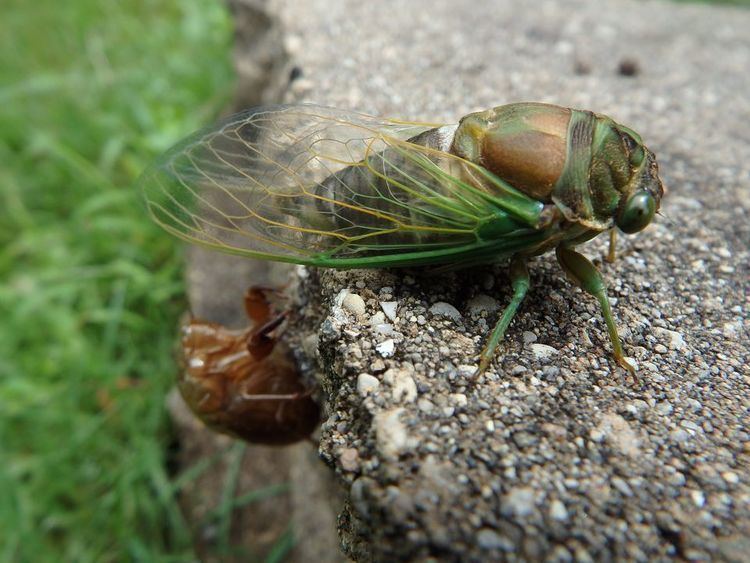 | ||
Lower classifications Periodical cicadas, Tanna japonensis, Dog‑day cicada, Lyristes plebejus, Cicada orni | ||
The cicadas (/sɪˈkɑːdə/ or /sɪˈkeɪdə/) are a superfamily, the Cicadoidea, of insects in the order Hemiptera (true bugs). They are in the suborder Auchenorrhyncha, along with smaller jumping bugs such as leafhoppers and froghoppers. It is divided into the Tettigarctidae, with two species in Australia, and Cicadidae, with more than 1,300 species described from around the world; many undescribed species remain.
Contents
- Cicadas insects emerging after 17 years underground
- Etymology
- Taxonomy and diversity
- Palaeontology
- Description
- Temperature regulation
- Song
- Life cycle
- Diet
- Locomotion
- Predators parasites and pathogens
- Antipredator adaptations
- In art and literature
- In music
- In mythology and folklore
- As food and folk medicine
- As pests
- References
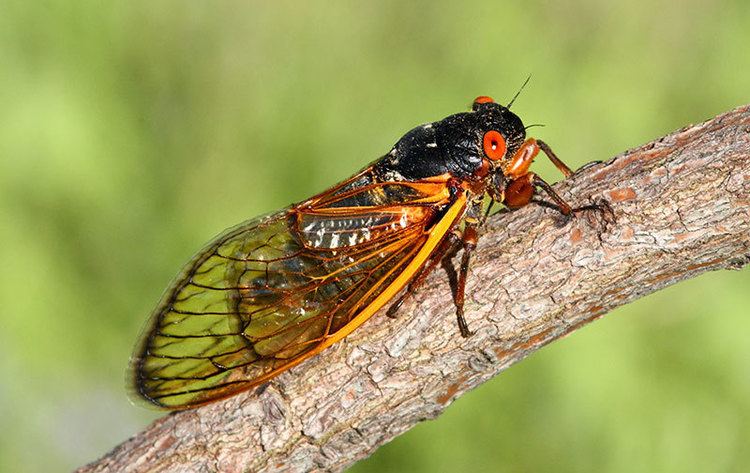
Cicadas have prominent eyes set wide apart, short antennae, and membranous front wings. They have an exceptionally loud song, produced not by stridulation, but by vibrating drumlike tymbals rapidly. The earliest known fossil Cicadomorpha appeared in the Upper Permian period; extant species occur all around the world in temperate to tropical climates. They typically live in trees, feeding on sap, and laying their eggs in a slit in the bark. Most cicadas are cryptic, singing at night to avoid predators. The periodic cicadas spend most of their lives as underground nymphs, emerging only after 13 or 17 years, which may reduce losses by starving their predators and eventually emerging in huge numbers which overwhelm and satiate any remaining predators.
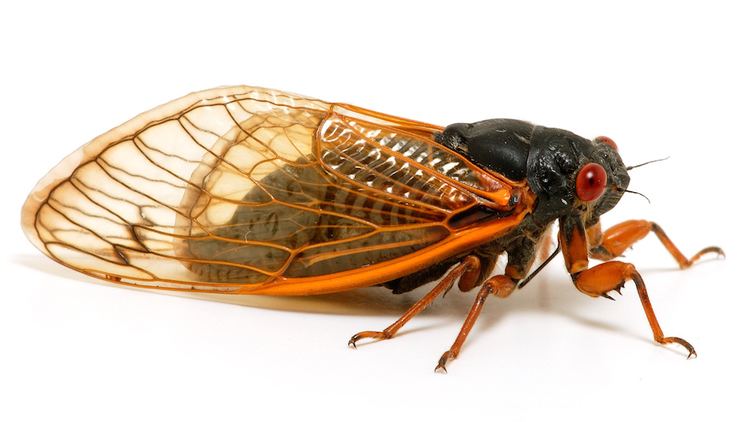
Cicadas have been featured in literature since the time of Homer's Iliad, and as motifs in art from the Chinese Shang dynasty. They have been used in myths and folklore to represent carefree living and immortality. Cicadas are eaten in various countries, including China, where the nymphs are served deep-fried in Shandong cuisine.
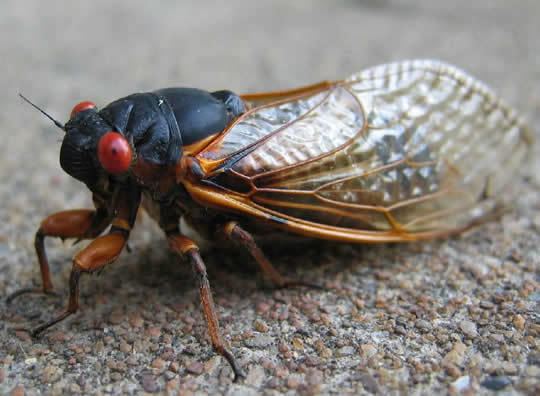
Cicadas insects emerging after 17 years underground
Etymology
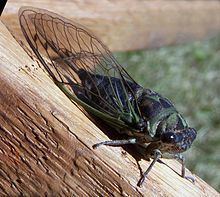
The name is a direct derivation of the Latin cicada, meaning "tree cricket". American English of central Appalachia retains the name "jarfly".
Taxonomy and diversity
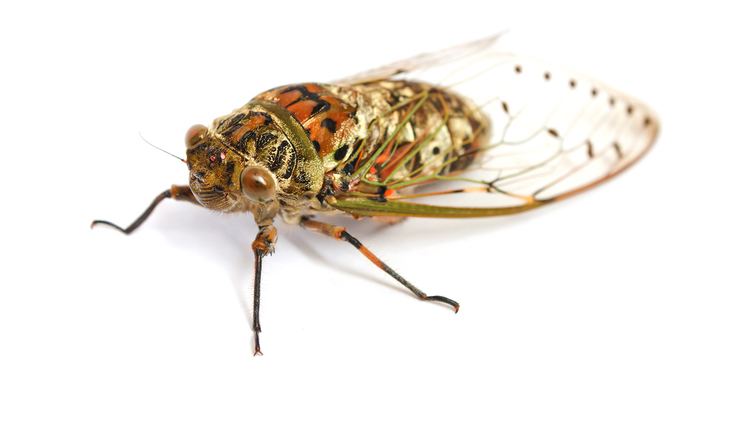
Cicadas are arranged into two families: the Tettigarctidae and Cicadidae. The two extant species of Tettigarctidae include one in southern Australia and the other in Tasmania. The family Cicadidae is subdivided into the subfamilies Cicadinae, Tettigadinae, and Cicadettinae; they are found on all continents except Antarctica. Some previous works also included a family-level taxon called the Tibiceninae. The largest species is the Malaysian emperor cicada Megapomponia imperatoria; its wingspan is up to about 20 cm (8 in). They are also notable for the great length of time some species take to mature.
At least 1300 cicada species are distributed worldwide with the majority being in the tropics. Most genera are restricted to a single biogeographical region and many species have a very limited range. This high degree of endemism has been used to study the biogeography of complex island groups such as in Indonesia and the Orient. There are about 200 described species in Australia and New Zealand, around 150 in South Africa, over 170 in America north of Mexico, at least 800 in Latin America, and over 200 in Southeast Asia and the Western Pacific. About 100 species occur in the Palaearctic. A few species are found in southern Europe, and a single species is in England, the New Forest cicada, Melampsalta montana, which also occurs in continental Europe.
Most of the North American species are in the genus Neotibicen: the annual or jar fly or dog-day cicadas (so named because they emerge in late July and August). The best-known North American genus, however, is Magicicada. These periodical cicadas have an extremely long life cycle of 13 or 17 years, suddenly and briefly emerging in large numbers.
Australian cicadas are found on tropical islands and cold coastal beaches around Tasmania, in tropical wetlands, high and low deserts, alpine areas of New South Wales and Victoria, large cities like Sydney, Melbourne, and Brisbane, and Tasmanian highlands and snowfields. Many of them go by common names such as cherry nose, brown baker, red eye, greengrocer, yellow Monday, whisky drinker, double drummer, and black prince. The Australian greengrocer, Cyclochila australasiae, is among the loudest insects in the world.
Forty-two species from five genera populate New Zealand, ranging from sea level to mountain tops, and all are endemic to New Zealand and the surrounding islands (Norfolk Island, New Caledonia).
Palaeontology
Fossil Cicadomorpha first appeared in the Upper Permian. The superfamily Palaeontinoidea contains three families. The Upper Permian Dunstaniidae are found in Australia and South Africa, and also in younger rocks from China. The Upper Triassic Mesogereonidae are found in Australia and South Africa.
The Palaeontinidae or "giant cicadas" come from the Jurassic and Upper Cretaceous of Eurasia and South America. The first of these was a forewing discovered in the Taynton Limestone Formation of Oxfordshire, England; it was initially described as a butterfly in 1873, before being recognised as a cicada and renamed Palaeontina oolitica.
Description
Cicadas are large insects made conspicuous by the courtship calls of the males. They are characterised by having three joints in their tarsi, and having small antennae with conical bases and three to six segments, including a seta at the tip. The Auchenorrhyncha differ from other hemipterans by having a rostrum that arises from the posteroventral part of the head, complex sound-producing membranes, and a mechanism for linking the wings which involves a down-rolled edging on the rear of the forewing and an upwardly protruding flap on the hindwing. Cicadas lack the ability to jump as exhibited by other members of the Auchenorrhyncha. Another defining characteristic is the adaptations of the forelimbs of nymphs for underground life. The relict family Tettigarctidae differ from the Cicadidae in having the prothorax extending as far as the scutellum, and by lacking the tympanal apparatus.
The adult insect, known as an imago, is 2 to 5 centimetres (1–2 in) in total length in most species, although the largest, the empress cicada (Megapomponia imperatoria), has a head-body length of about 7 centimetres (2.8 in), and its wingspan is 18 to 20 centimetres (7–8 in). Cicadas have prominent compound eyes set wide apart on the sides of the head. The short antennae protrude between the eyes or in front of them. They also have three small ocelli located on the top of the head in a triangle between the two large eyes, and this distinguishes cicadas from other members of the Hemiptera. The mouthparts form a long sharp rostrum which they insert into the plant to feed. The post-clypeus is a large, nose-like structure that lies between the eyes and makes up most of the front of the head: it contains the pumping musculature.
The thorax has three segments and houses the powerful wing muscles. They have two pairs of membranous wings that may be hyaline, cloudy or pigmented. The wing venation varies between species and may help in identification. The middle thoracic segment has an operculum on the underside which may extend posteriorly and obscure parts of the abdomen. The abdomen is segmented, with the hindermost segments housing the reproductive organs, and terminates in females with a large, saw-edged ovipositor. In males, the abdomen is largely hollow and used as a resonating chamber.
The surface of the forewing is super-hydrophobic; it is covered with minute waxy cones, blunt spikes which create a water-repellent film. Rain rolls across the surface, removing dirt in the process. In the absence of rain, dew condenses on the wings. When the droplets coalesce, they leap several millimetres into the air, which also serves to clean the wings. It has been found that bacteria landing on the wing surface are not repelled, rather their membranes are torn apart by the nanoscale-sized spikes, making the wing surface the first-known biomaterial that can kill bacteria.
Temperature regulation
Desert cicadas such as Diceroprocta apache are unusual among insects in controlling their temperature by evaporative cooling, analogous to sweating in mammals. When their temperature rises above about 39 °C, they suck excess sap from the food plants and extrude the excess water through pores in the tergum at a modest cost in energy. Such a rapid loss of water can be sustained only by feeding on water-rich xylem sap. At lower temperatures, feeding cicadas would normally need to excrete the excess water. By evaporative cooling, desert cicadas can reduce their bodily temperature by some 5 °C. Some non-desert cicada species such as Magicicada tredecem also cool themselves evaporatively, but less dramatically. Conversely, many other cicadas can voluntarily raise their body temperatures as much as 22 °C (40 °F) above ambient temperature.
Song
The "singing" of male cicadas is not stridulation such as many familiar species of insects produce—for example crickets. Instead, male cicadas have a noisemaker called a tymbal below each side of the anterior abdominal region. The tymbals are structures of the exoskeleton formed into complex membranes with thin, membranous portions and thickened ribs. Contraction of internal muscles buckles the tymbals inwards, thereby producing a click; on relaxation of the muscles, the tymbals return to their original position, producing another click. The male abdomen is largely hollow, and acts as a sound box. By rapidly vibrating these membranes, a cicada combines the clicks into apparently continuous notes, and enlarged chambers derived from the tracheae serve as resonance chambers with which it amplifies the sound. The cicada also modulates the song by positioning its abdomen toward or away from the substrate. Partly by the pattern in which it combines the clicks, each species produces its own distinctive mating songs and acoustic signals, ensuring that the song attracts only appropriate mates.
Average temperature of the natural habitat for the South American species Fidicina rana is approximately 29 °C (84 °F). During sound production, the temperature of the tymbal muscles was found to be significantly higher. Many cicadas sing most actively during the hottest hours of a summer day; roughly a 24-hour cycle.
Although only males produce the cicadas' distinctive sound, both sexes have membraneous structures called tympana by which they detect sounds; the equivalent of having ears. Males disable their own tympana while calling, thereby preventing damage to their hearing; a necessity partly because some cicadas produce sounds up to 120 dB (SPL) which is among the loudest of all insect-produced sounds. The song is loud enough to cause permanent hearing loss in humans should the cicada sing just outside the listener's ear. In contrast, some small species have songs so high in pitch that the noise is inaudible to humans.
For the human ear, it is often difficult to tell precisely where a cicada song originates. The pitch is nearly constant, the sound is continuous to the human ear, and cicadas sing in scattered groups. In addition to the mating song, many species have a distinct distress call, usually a broken and erratic sound emitted by the insect when seized or panicked. Some species also have courtship songs, generally quieter, and produced after a female has been drawn to the calling song. Males also produce encounter calls, whether in courtship or to maintain personal space within choruses.
The song of cicadas is considered by entomologists to be unique to a given species, and a number of resources exist to collect and analyse cicada sounds.
Life cycle
In some species of cicada, the males remain in one location and call to attract females. Sometimes several males aggregate and call in chorus. In other species, the males move from place to place, usually with quieter calls while searching for females. The Tettigarctidae differ from other cicadas in producing vibrations in the substrate rather than audible sounds. After mating, the female cuts slits into the bark of a twig where she deposits her eggs.
When the eggs hatch, the newly hatched nymphs drop to the ground and burrow. Cicadas live underground as nymphs for most of their lives at depths down to about 2.5 metres (8 ft). Nymphs have strong front legs for digging and excavating chambers in close proximity to roots where they feed on xylem sap. In the process, their bodies and interior of the burrow become coated in anal fluids. In wet habitats, larger species construct mud towers above ground in order to aerate their burrows. In the final nymphal instar, they construct an exit tunnel to the surface and emerge. They then moult (shed their skins) on a nearby plant for the last time, and emerge as adults. The exuviae or abandoned exoskeletons remain, still clinging to the bark of the tree.
Most cicadas go through a life cycle that lasts from two to five years. Some species have much longer life cycles, such as the North American genus, Magicicada, which has a number of distinct "broods" that go through either a 17-year or, in some parts of the world, a 13-year life cycle. The long life cycles may have developed as a response to predators, such as the cicada killer wasp and praying mantis. A specialist predator with a shorter life cycle of at least two years could not reliably prey upon the cicadas.
Diet
Cicada nymphs drink sap from the xylem of various species of trees, including oak, cypress, willow, ash, and maple. While it is common folklore that adults do not eat, they actually do drink plant sap utilizing their sucking mouthparts.
Locomotion
Cicadas, unlike other Auchenorrhyncha, are not adapted for jumping (saltation). They have the usual insect modes of locomotion, walking and flight. However, they do not walk or run well, and take to the wing to travel distances greater than a few centimetres. Cicadas can extend their hindlegs in under a millisecond to execute a jump, implying elastic storage of energy for sudden release.
Predators, parasites and pathogens
Cicadas are commonly eaten by birds and sometimes by squirrels, as well as bats, wasps, mantises, spiders and robber flies. In times of mass emergence of cicadas, various amphibians, fish, reptiles, mammals and birds change their foraging habits so as to benefit from the glut. Newly hatched nymphs may be eaten by ants, and nymphs living underground are preyed on by burrowing mammals like moles. In Australia, cicadas are preyed on by the Australian cicada killer wasp (Exeirus lateritius), which stings and stuns cicadas high in the trees, making them drop to the ground where the cicada-hunter mounts and carries them, pushing with its hindlegs, sometimes over a distance of a hundred metres, until they can be shoved down into its burrow, where the numb cicada is placed onto one of many shelves in a "catacomb", to form the food-stock for the wasp grub that grows out of the egg deposited there.
Several fungal diseases infect and kill adult cicadas while another entomopathogenic fungus, Cordyceps spp., attacks nymphs. Massospora cicadina specifically attacks the adults of periodical cicadas, the spores remaining dormant in the soil between outbreaks.
Antipredator adaptations
Cicadas use a variety of strategies to evade predators. Large cicadas can fly rapidly to escape if disturbed. Many are extremely well camouflaged to evade predators such as birds that hunt by sight. As well as being coloured like tree bark, they are disruptively patterned to break up their outlines; their partly transparent wings are held over the body and pressed close to the substrate. The wings are antireflective, avoiding the typical shine of insect cuticle which would break the cicada's camouflage.
The periodical cicadas (Magicicada) make use of predator satiation: they emerge, all at once, at long intervals of 13 or 17 years; their juveniles are probably the longest-lived of all insect development stages. Since the number of cicadas in any given area exceeds the amount predators can eat, all available predators are satiated, and the remaining cicadas can breed in peace.
Some cicadas such as Hemisciera maculipennis display bright deimatic flash coloration on their hindwings when threatened; the sudden contrast helps to startle predators, giving the cicadas time to escape. The majority of cicadas are nocturnal and rely on camouflage when at rest, but some species are aposematic; the Malaysian Huechys sanguinea has conspicuous red and black warning coloration, is diurnal, and boldly flies about in full view of possible predators.
Predators such as the sarcophagid fly Emblemasoma hunt cicadas by sound, being attracted to their song. Singing males soften their song so that the attention of the listener gets distracted to neighbouring louder singers, or cease singing altogether as a predator approaches. It has been asserted that loud cicada song, especially in chorus, repels predators, but observations of predator responses refute the claim.
In art and literature
Cicadas have been featured in literature since the time of Homer's Iliad, and as motifs in decorative art from the Chinese Shang dynasty (1766–1122 BC.). They are described by Aristotle in his History of Animals and by Pliny the Elder in his Natural History; their mechanism of sound production is mentioned by Hesiod in his poem Works and Days "when the Skolymus flowers, and the tuneful Tettix sitting on his tree in the weary summer season pours forth from under his wings his shrill song". In the classic 14th-century Chinese novel Romance of the Three Kingdoms, Diaochan took her name from the sable (diāo) tails and jade decorations in the shape of cicadas (chán), which adorned the hats of high-level officials. In the Japanese novel The Tale of Genji, the title character poetically likens one of his many love interests to a cicada for the way she delicately sheds her robe the way a cicada sheds its shell when molting. A cicada exuviae plays a role in the manga Winter Cicada. Cicadas are a frequent subject of haiku, where, depending on type, they can indicate spring, summer or autumn.
In music
Cicadas are featured in the well-known protest song "Como La Cigarra" ("Like the Cicada") written by the Argentinian poet and composer, María Elena Walsh. In the song, the cicada is a symbol of survival and defiance against death. "Como La Cigarra" was famously recorded by Mercedes Sosa, among other Latin American musicians. Another well-known song, "La Cigarra" ("The Cicada"), written by Raymundo Perez Soto, is a song in the mariachi tradition which romanticises the insect as a creature that sings until it dies.
In mythology and folklore
Cicadas have been used as money, in folk medicine, to forecast the weather, to provide song (in China), and in folklore and myths around the world. In France, the cicada represents the folklore of Provence and the Mediterranean cities.
The cicada has represented insouciance since classical antiquity. Jean de La Fontaine began his collection of fables Les fables de La Fontaine with the story La Cigale et la Fourmi (The Cicada and the Ant) based on one of Aesop's fables: in it the cicada spends the summer singing while the ant stores away food, and finds herself without food when the weather turns bitter.
The cicada symbolises rebirth and immortality in Chinese tradition. In the Chinese essay "Thirty-Six Stratagems", the phrase "to shed the golden cicada skin" (simplified Chinese: 金蝉脱壳; traditional Chinese: 金蟬脫殼; pinyin: jīnchán tuōqiào) is the poetic name for using a decoy (leaving the exuviae) to fool enemies. In the Chinese classic novel Journey to the West (16th century), the protagonist Priest of Tang was named the Golden Cicada.
In Japan, the cicada is associated with the summer season. According to Lafcadio Hearn, the song of Meimuna opalifera, called "tsuku-tsuku boshi", is said to indicate the end of summer, and it is called so because of its particular call.
In an Ancient Greek myth, Tithonus eventually turns into a cicada after being granted immortality, but not eternal youth, by Zeus. The Greeks also used a cicada sitting on a harp as emblematic of music.
As food and folk medicine
Cicadas were eaten in Ancient Greece, and are consumed today in China, both as adults and (more often) as nymphs, in Malaysia, Burma, Latin America, and central Africa. Female cicadas are prized for being meatier. Shells of cicadas are employed in traditional Chinese medicines.
In 2011, cicadas were incorporated into a single batch of ice cream in Columbia, Missouri, at Sparky's. The ice creamery was advised by the public health department against making a second batch, a suggestion with which store owners complied.
As pests
Cicadas feed on sap, and are benign to humans; they do not bite or sting in a true sense, but may occasionally mistake a person's arm for a plant limb and attempt to feed.
Cicadas are not major agricultural pests but in some outbreak years, trees may be overwhelmed by the sheer numbers of females laying their eggs in the shoots. Small trees may wilt and larger trees may lose small branches. Although in general, the feeding activities of the nymphs do little damage, during the year before an outbreak of periodic cicadas, the large nymphs feed heavily and plant growth may suffer. Some species have turned from wild grasses to sugar cane, and this has affected the crop adversely, and in a few isolated cases, females have oviposited on food crops such as date palms, grape vines, citrus trees, asparagus and cotton.
Cicadas sometimes cause damage to amenity shrubs and trees, mainly in the form of scarring left on tree branches where the females laid their eggs. Branches of young trees may die as a result.
